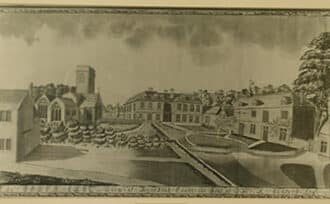Church History
Below is a short history of the church in Nynehead. Find out more about the history of the Parish in the online Nynehead Archive
Timeline of the Church at Nynehead
Early History
The manor was granted to the Bishop of Winchester in 737 AD, so it is likely there was some form of a church here at that time. A church in Nynehead is mentioned in the Domesday Book of 1068. By a charter dated 1091, William, Count of Mortain, founder of the Montacute Priory, granted to the monks of Montacute the manor and the church of Nynehead. It was the only Cluniac Order in the county, an order that was developed from Cluny in Burgundy. It is probable that there was also a simple church on this site in A.D 890 because the condition of renting the manor was that the tenant should follow and worship the Lord.
11th Century
A church at Nynehead is mentioned in the Domesday Book of 1068. Then by a charter dated 1091, William, Count of Mortain, founder of the Montacute Priory, granted to the monks of Montacute the manor and church. The Montacute Priory was founded by William, Count of Mortain, in about 1100. It was the only Cluniac Order in the county, an order which was developed from Cluny in Burgundy.
13th Century
In 1292 the rectorial tithe was worth six and a half marks. A mark was a bar of silver, weighing about half a pound. The tithe at this time went to the Taunton Priory, as one of the monks would have served as the parish priest. The canons and monks had beards, their habit was a black cassock over which was a white rochet, with a black cloak and hood and a cap on the head. As is the case with most church buildings, various alterations and additions have been made over a period of time.
16th Century
After the Reformation the tithe reverted to the Crown. In 1554 Queen Mary presented a vicar to the parish. Then Queen Elizabeth 1 presented three vicars in 1564, 1567 and 1570.
17th Century Onwards
James 1 presented one vicar in 1618. Charles 1st presented the vicar in 1638. Charles 2nd presented 2 vicars; William 3rd, George 1st , George 2nd and George 3rd all presented vicars to Nynehead. The last vicar to be presented by the Crown was Dr Thomas Bovet in 1786; after this the patronage came into the possession of the Sanford family until the late 20th century. The Sanford family lived in Nynehead Court between 1590 and 1919.
From a picture of the church and Nynehead Court in 1859 it appears as if the church-house was to the east of the church. According to Jeboult, in 1873 a new vicarage was built in a field to the North East of the Church, which in fact is at the top of Nynehead hollow. Prior to this new vicarage, the vicarage was the thatched house adjacent to the present pre-school.
The Naming of ‘Nynehead’
The name Nynehead is unique as it is the only place with this name in the world. Documentary evidence of human settlement can be traced back to Saxon times, while the archeological record pushes the boundary much further back. The first date Nynehead was mentioned was in 737 A.D. when the Manor was granted to the Bishop of Winchester. In A.D. 890 land was granted to a Wulfhere Gidding, at a yearly rent of 20 shillings “on condition that the tenant shall be a follower of the Lord of the church.” The actual name Nynehead is derived from the area of the Parish at that time which was nine hides i.e. Nigonhidon (A.D. 897) which then gradually changed over the years e.g. Nichehede (1086); Neghenhude (1327); Nyenhide (1410; finally Nynehead in the 19th century.
The name Nynehead is of Anglo-Saxon origin. A hide is a unit of land measurement thought to equal 120 modern acres so ‘9 hides’ equates to about 1000 acres. In 1091 the Manor and the church were granted to the Fleury family and the name then changed to Nynehead Florey which referred to the area around the church and Court and East Nynehead was Nynehead Monks.
The Parish Coffer
At the west end of the church under the tower stands the church chest. In 1559 Queen Elizabeth 1 ordered that a chest with three different locks be provided in which to keep the registers and other important papers of the church. The Vicar kept one key, and the churchwardens the other two. The result was that no one person could open the chest, all three had to be present. The present chest was purchased in 1728 from William Cox for 10s-0d (50p). The three locks cost 2s-0d (10p), and the clasps 7s-6d (37½ p).
The parish coffer contained the usual parish papers – books of accounts, apprenticeship indentures and a warrant for the burial of a fel-de-se at the crossroads.




